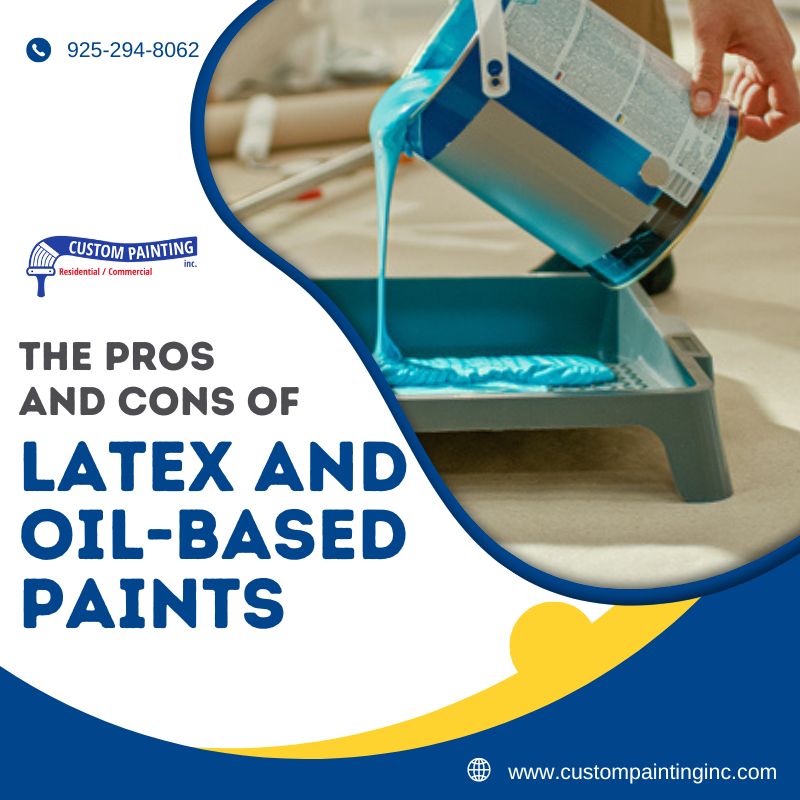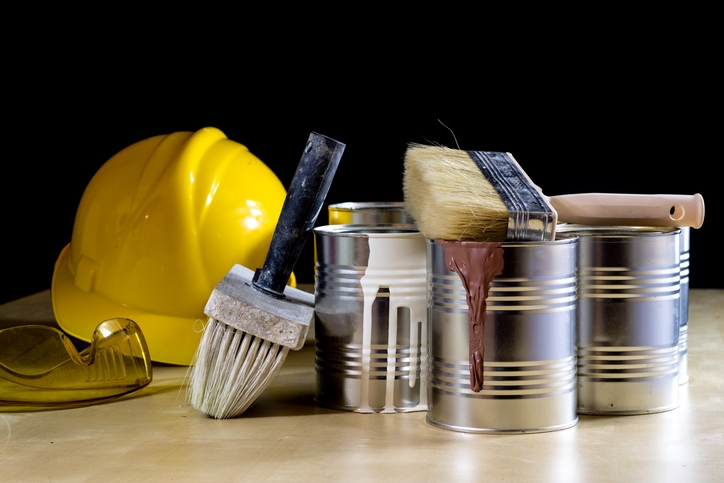While planning for a house painting project, choosing the right type of paint is crucial as it ensures durability, ease of maintenance, and the desired finish. The appropriate paint can resist moisture, mildew, and stains, particularly in high-humidity areas like bathrooms. It also provides better coverage, longevity, and aesthetic appeal, matching the specific needs of the room and surface you paint.
There are two types of paint: latex (water-based) and oil-based paints. If you think they’re the same, each has different properties and required applications.
Latex (water-based paints)
Latex or water-based paints consist of a pigment and a binder. It uses water as a carrier or liquefying agent instead of chemical solvents. They are relatively recent innovation but have become the most popular choice among DIY and professional painters.
Since latex paints are water-based, they are much easier to clean up with soap and water. They typically have low amounts of volatile organic compounds (VOCs), so they are low in odor and thus generally safe and comfortable to work with.
Here’s a list of quick facts about latex paints, along with their pros and cons:
1. Composition
- Made with water as the primary solvent.
- Latex paints contain pigments and binders like acrylic or latex.
2. Characteristics
- Low VOC (volatile organic compounds) levels, making them more eco-friendly.
- Quick drying time.
- They are easier to clean up with only water and soap.
- Less odor compared to oil-based paints.
- Flexible and resistant to cracking.
- Suitable for various surfaces, including walls, trim, and ceilings.
3. Uses
- They are ideal for indoor use, especially in areas with good ventilation.
- They are commonly used for walls, ceilings, and general household painting projects.
4. Pros of latex paints
- Easy to clean up: Latex paints can be cleaned with soap and water, making them easier to clean than oil-based paints, which require solvents.
- Quick drying time: Latex paints dry relatively quickly, allowing for faster project completion and multiple coats to be applied in one day.
- Low odor: These paints tend to have lower amounts of volatile organic compounds (VOCs), resulting in less odor and fewer health risks than oil-based paints.
- Flexibility: Latex paint forms a flexible, durable surface that can expand and contract with changing temperatures, reducing the risk of cracking and peeling.
- Fade-resistant: Latex paints are resistant to UV rays, making them a good choice for exterior applications where sun exposure is a concern.
- Environmental benefits: Because they are water-based, latex paints are less harmful to the environment and easier to dispose of than oil-based paints.
- Easy to apply: Latex paints are known for their smooth application, making them easier to work with for both professionals and DIYers.
5. Cons of latex paints
- Less durable on high-traffic surfaces: While latex paints are durable, they may not be as tough as oil-based paints on high-traffic surfaces or areas subject to heavy wear and tear.
- Not ideal for metal surfaces: Latex paints can promote rust on unprimed metal surfaces. Metal applications often require oil-based paints or special primers.
- Requires more coats: In some cases, latex paint may require more coats than oil-based paint to achieve the desired coverage and finish, especially on darker or glossier surfaces.
- Temperature sensitivity: Latex paint should not be applied in freezing temperatures, as it can affect its drying and curing.
- May raise wood grain: When applied to wood, latex paint can cause the grain to swell, potentially requiring additional sanding to achieve a smooth finish.
Latex paints are a versatile and user-friendly option for many painting projects, offering several benefits in ease of use, environmental impact, and quick drying times. However, don’t forget to consider the specific requirements of your project to determine if latex paint is the best choice.
Oil-based Paints
Before the advent of water-based paints, oil-based paints had already been around for a long time. They were once the only paint choice. Oil-based paints quickly bond to any surface. One coat of oil-based paint is usually enough to provide sufficient coverage. Since oil-based paints take time to dry, they allow smoothness to the surface.
Oil-based paints usually provide a smooth and glossy finish, ideal for rooms with high traffic and humidity, such as bathrooms, kitchens, and children’s playrooms.
Here’s a list of the quick facts about oil-based paints, plus their pros, cons, and applications:
1. Composition
- Made with oil or alkyd as the primary solvent.
- They contain pigments and resins.
2. Characteristics
- Higher levels of VOCs can harm the environment and require proper ventilation.
- Longer drying time, allowing for a smoother finish.
- More durable and resistant to wear and tear.
- They are harder to clean up, requiring solvents like mineral spirits or turpentine.
- They are more odorous than water-based paints.
- They tend to yellow over time, especially in low-light areas.
Uses:
- They are ideal for surfaces that need a hard, durable finish, such as trim, doors, and furniture.
- They are often used for exterior painting projects due to their durability and weather resistance.
Oil-based paints have been popular for many projects due to their durability and finish quality. However, they come with both advantages and disadvantages:
3. Pros of oil-based paints
- Durability: Oil-based paints are highly durable and can withstand wear and tear, making them ideal for high-traffic areas and surfaces that require frequent cleaning.
- Smooth finish: These paints provide a more even and flawless finish than water-based paints, which can be especially beneficial for flawed surfaces.
- Good coverage: Oil-based paints often provide better coverage with fewer coats, saving time and effort.
- Resistant to moisture: They are more moisture-resistant, making them suitable for humid areas like kitchens and bathrooms.
- Longer drying time: While this can be a disadvantage, the longer drying time allows the paint to level out, reducing brush strokes and providing a more professional finish.
Cons of oil-based paints
- Longer drying time: The longer drying time can be inconvenient, especially for projects requiring quick completion.
- Strong odor: Oil-based paints emit strong fumes and require good ventilation. Prolonged exposure to these fumes can be harmful.
- Clean-up: Cleaning brushes, rollers, and other tools used with oil-based paints require solvents like turpentine or mineral spirits, which can be messy and potentially hazardous.
- Environmental concerns: Oil-based paints contain volatile organic compounds (VOCs), which harm the environment and indoor air quality.
- Yellowing over time: Oil-based paints can yellow with age, especially in areas not exposed to natural light.
- Cost: They tend to be more expensive than water-based paints.
Applications
Oil-based paints are best suited for:
- Trim, doors, and cabinetry where a smooth, hard finish is desired.
- High-moisture areas like bathrooms and kitchens.
- Surfaces requiring frequent cleaning.
These pros and cons can help you decide whether oil-based paints are the best for your paint project.
Conclusion
Select the correct paint type for the best finish on your DIY paint projects. Choose oil-based paints for their durability and smooth finish, especially on walls, ceilings, trim, doors, and cabinetry. However, if you prefer a faster drying time, lower fumes, and easier clean-up, choose high-quality water-based paints. Always ensure good ventilation and use the appropriate tools for a professional look.
If you want a flawless finish without the hassle, contact Custom Painting, Inc. by phone (925-294-8062) or message (contact form) for a free estimate. Our expertise and experience ensure high-quality results, saving you time and effort. Get in touch with us today to transform your space with a perfect paint job!



